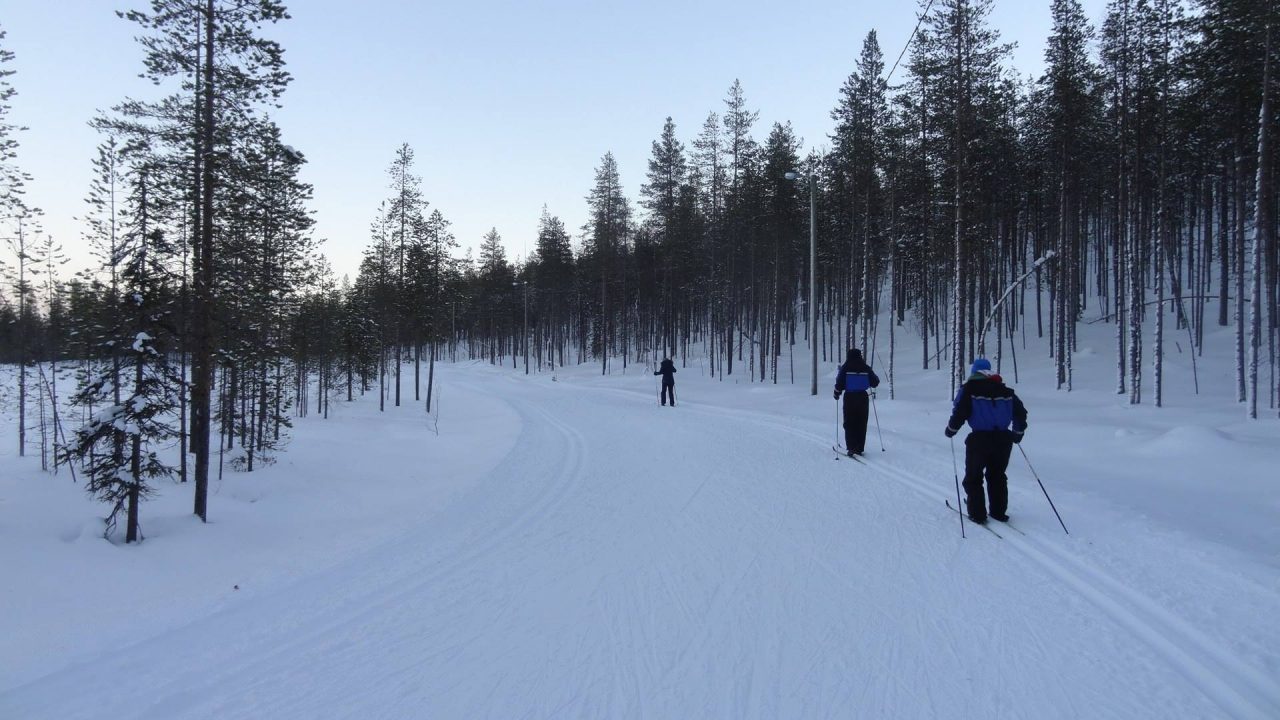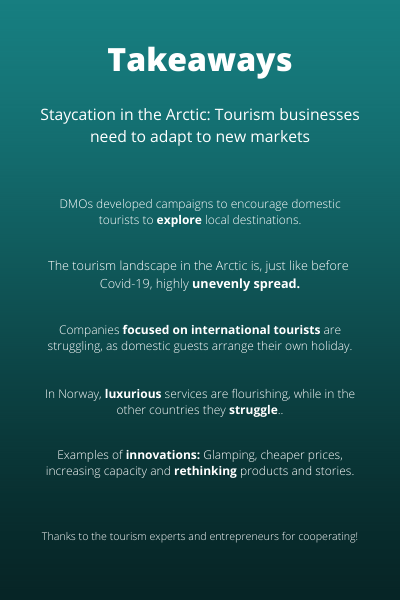Text: Elsbeth Bembom
How has Covid–19 affected Arctic tourism and what challenges, trends and innovations are on the rise among local tourism entrepreneurs? During the last few weeks, Elsbeth Bembom from ARCTISEN has been talking to tourism experts from Greenland, Norway, Sweden and Finland to explore Arctic’s current tourism landscape. Corona-proof, behind her desk.
While the concept of staycation in recent years has often been associated with strategies to reduce negative environmental impacts and flight shame, 2020 was the year where staycation became the new normal for tourists all around the world. While countries turned orange and red on the world map and lockdowns were enforced to stop the spread of the coronavirus, several positive stories also appeared in the news in the summer of 2020. Many destinations in Europe welcomed a record-high number of visitors, for instance in Denmark, where tourists could take the ferry for free to support island tourism. Despite some of these successful staycation hotspots, the overall industry is suffering, with UNWTO predicting a global drop of 70% in international arrivals in 2020.
But what has happened to tourism in the Arctic regions? Did the staycation trend boom in the North as well? As a destination, the Arctic is a highly diverse area with different cultures, tourism developments and products and, as a consequence, Covid-19 responses. It came therefore as no surprise that we heard many different and even contrasting stories from destination managers at local DMOs. As became clear from all the interviews with these tourism experts, some tourism businesses flourished this summer and welcomed more guests than ever before, while others were forced to shut down their business. So, what Arctic experiences attracted the exploded home market in 2020 and which did not cater for domestic staycation guests? Let’s explore the Arctic tourism landscape in times of the Covid-19 pandemic.
A staycation boom
After the many cancellations in March, some destinations received a record high number of domestic tourists due to the global travel restrictions. While domestic tourism is not a new phenomenon to the Arctic regions, the staycation trend has not been observed before to this extent. As Salik Hard, senior project manager at Semersooq Business Council, stated: “I think it’s this summer, we actually had more guests than we had normally, because we did a lot of things on the staycation activities”. What most of the popular destinations had in common this summer, was their rural and remote character. As the chairman of a local tourist organization in Northern Sweden explained, the mountain areas received many guests since “we feel it is safe to go to the mountains” to prevent the spread of the coronavirus.
From a DMO perspective, several national and regional campaigns have been developed to attract domestic tourists and to support local tourism entrepreneurs, such as the Greenlandic Nunarput Nuan campaign, which aims to encourage people in Greenland to discover their own country. Similarly, the Destinasjon Sápmi campaign tries to inform Norwegians of the hidden Sámi gems in the North. These campaigns are specifically focused on domestic tourists, as, for instance, the websites are only available in local languages.
Basic or high-end experiences on the rise?
Companies that failed to benefit from the staycation boom included mostly expensive offerings that were mainly targeted at foreign tourists. For instance, many tour operators who organize activities such as zodiac tours, husky or reindeer visits and snowmobile safaris experienced a difficult summer. Kristian Sievers from the Regional council of Lapland believes that this development is caused because “the Finns come for the sort of more self catering holidays”, where they bring their own skies and bikes and prepare their own meals. To adapt to this Finnish market, Kristian observed that companies lowered their prizes. Similarly, in Jokkmokk, Northern Sweden, a great deal of the high-standard restaurants went bankrupt and in Greenland, Salik Hard saw extravagant glamping sites and big hotels struggling to run their businesses.
Quite remarkably, in Norway and to a lesser extent also Sweden, these exact luxurious accommodations and services were in explosive demand among domestic tourists. This resulted in dining at high-end restaurants to become the biggest trend among Norwegian visitors to Northern Norway over the summer. As Hilde Bjørkli, head of competence and development at the Northern Norway Tourism Board, described: “The [tour] boats were not used that much, but the kitchen was used a lot. And so, [the entrepreneurs] realize that Norwegians have to be treated in a different way.” While the Norwegian tour sector was at risk, some managed to save the season by offering food services instead. Similarly, some Sámi tourism businesses adapted their products to attract domestic tourists by, for instance, upgrading their accommodation to glamping lavvu’s, which is a traditional Sámi tent, and improving their food services with an outdoor BBQ and wine menus.
Away from the popular destinations
Yet, many Indigenous tourism entrepreneurs in the Scandinavian Arctic suffered over the summer as they often host international guests arriving from cruise ships or boat tours. Correspondingly, tourism businesses in remote regions in Greenland, like Tasiilaq, which rely on cruise guests, have been dramatically hit, impacting the entire local community. However, some entrepreneurs were successful to invert this catastrophic situation by moving their tours to the tourism hotspot in Nuuk. According to Salik Hard, those who quickly managed to increase their capacity were able to profit from the Greenlandic staycation boom. As an example, the owner of a cruise company in Nuuk increased its capacity by offering short boat trips out of Nuuk to domestic tourists. Similar to Tasiilaq, local communities in Sisimiut also noticed the severe consequences of the absent cruise ships. As a response, tour operators took the opportunity to rethink their products, services and stories. Jesper Schrøder, destination manager at Arctic Circle Business, spoke with many tourism entrepreneurs in Sisimiut, who used the slow season to renovate cabins for longer stays and to come up with new ideas on how to use their sledge dogs in the summer season.
What’s next?
All developments considered, Arctic tourism in times of Covid-19 consists of a highly fragmented landscape where some services and destinations peaked through the sky, while in the valleys, some businesses found it hard to adapt. Despite some destinations experiencing growth, the level of tourism in the summer of 2020 has been much lower than previous years. Many local tourism entrepreneurs have been forced to downsize their business or fire employees to keep their head above water. Thankfully, some entrepreneurs have found strategies and innovations to transform their products, within just one season, to a whole new market. Since we are still in the middle of the crisis, the development sketched out in this blog triggers many new questions. Which innovations are there to stay when international visitors can be welcomed again? Can the experience with domestic markets offer clues towards the future development for a more sustainable Arctic tourism, as more people might increasingly consider a staycation? And, very relevant to ARCTISEN, what are the consequences of more domestic guests for the development of culturally sensitive tourism? Stay tuned for a new blog on domestic tourism and cultural sensitivity!



